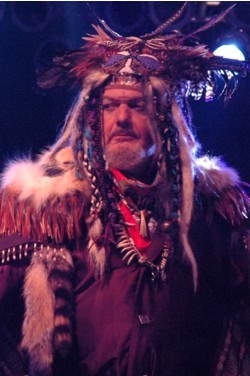Shows
Dr. John & the Lower 911 w/Al Kooper & the Funky Faculty
July 25, 2009 at Hart Theater at The Egg in Albany‚ NY
by J Hunter | photography by Andrew Wyatt
August 17, 2009
Dr. John & the Lower 911 w/Al Kooper & the Funky Faculty
July 25, 2009 at Hart Theater at The Egg in Albany‚ NY
by J Hunter | photography by Andrew Wyatt
August 17, 2009
|
|
|
|
 |
||
|
|
|
There is no way Mac Rebennack, Jr. (aka Dr. John) could come from anywhere but New Orleans. It's not his grinning hipster patois, or the red-bordering-on-fuchsia suit he wore (accessorized by a fedora with a hatband that matched the suit), or even the human skull that sat amongst various percussion instruments on the grand piano in the center of the Hart Theatre's stage. It's because Dr. John's 90-minutes-plus set encompassed everything about music in the Crescent City.
It's a myth that NOLA's best musical representatives are the Preservation Hall Jazz Band. They're a great snapshot of one point in the city's cultural history, but they're not all there is - not by a long shot. New Orleans music is a sweet and savory gumbo of jazz, rock, R&B, blues, country, gospel, and about a hundred sub-genres that stem from those six schools. Basically, if you have a favorite musical flavor, NOLA can serve it with its own spin. Dr. John brought a little bit of everything to Albany on this night, and it was nothing but a party.
The good Doctor bopped slowly in from Stage Right as his backup band, the Lower 911, played him onstage. Once behind the piano, Rebennack effortlessly picked up the band's vamp and slid right into "Iko Iko." I've heard this song done by Dr. John, the Grateful Dead and the Dixie Cups, and none of the lyrics they used (apart from the call-and-answer chorus) were remotely the same. But with "Iko" (and with "Big Chief", the rollicking Professor Longhair classic that closed the regular set), it's not about "getting the words right" - it's getting the feeling right, nailing that groove that would make Mother Theresa get up and shake it on down. The Lower 911 had the groove going on from the outset, and Rebennack's signature vocal & piano style only made it better.
The Lower 911 is only a trio - guitarist John Fohl, bassist David Barard, and drummer Zigaboo Modeliste - so the Doctor had no horns to play with, and that was actually a plus! It stripped the music down to its bare essentials, rendering it raw and more intimate. This approach metaphorically shrank the Hart down to a hard-rocking juke joint as Rebennack rolled through material that included romping takes on "St. James Infirmary" and "Goodnight, Irene," energetic passes at early-career chestnuts "Right Place, Wrong Time" and "I Been Hoodooed," and incendiary tracks from the post-Katrina indictment City That Care Forgot. Opening act Al Kooper came out twice to literally back the Doctor on Hammond B3. (The organ was placed directly behind the Doctor with no separate stool, so Kooper had to stand as he played with his back to Rebennack.)
Al Kooper is rock & roll's answer to Zelig. Look at major rock moments of the 60's and 70's, and Kooper will probably be in the picture. He's on two of Bob Dylan's best albums, Highway 61 Revisited and Blonde on Blonde; being part of New York's seminal blues-rock fusion outfit The Blues Project; founding rock's first horn-based band, Blood Sweat & Tears; doing sessions for everyone from Jimi Hendrix to the Rolling Stones; working behind the scenes at the Monterey Pop Festival; and producing early recordings of artists like the Tubes, Nils Lofgren and Lynyrd Skynrd. Now that's a résumé!
Even though he's in his 11th year of a teaching gig at Berklee, Kooper's still rocking in the free world. The last time I saw him, he was backing up Joe Walsh on guitar and keyboards. Although Kooper played both instruments at this show, he primarily stuck with the B3 as he and his muscular sextet worked through a pleasurable, authentic hour of R&B-laced classics that included Dylan's "It Takes a Lot to Laugh, It Takes a Train to Cry" and a funky workup of the Blues Project's instrumental cult classic "Flute Thing."
Kooper's second visit to Dr. John's set was for a jammed-out "Wang Dang Doodle" that Rebennack prefaced as "not only in memory of Willie Dixon, but also in memory of Koko Taylor." Kooper and Dr. John share the same sense of musical history - though in Rebennack's case, the history he purveys is of a city that could well have died from not-so-benign neglect. All is still not well in NOLA, but all was well in Albany as we got a delicious taste of Crescent City cooking from one of the best ambassadors it's ever had.
related articles
Shows: NOLA Jazz & Heritage Festival
Shows: Gathering of the Vibes 2011
Shows: NOLA Jazz & Heritage Festival
Shows: NOLA Jazz & Hertiage Festival
Shows: Dr. John & The Neville Brothers
More on: Dr. John, Al Kooper
Shows: NOLA Jazz & Heritage Festival
Shows: Gathering of the Vibes 2011
Shows: NOLA Jazz & Heritage Festival
Shows: NOLA Jazz & Hertiage Festival
Shows: Dr. John & The Neville Brothers
More on: Dr. John, Al Kooper
